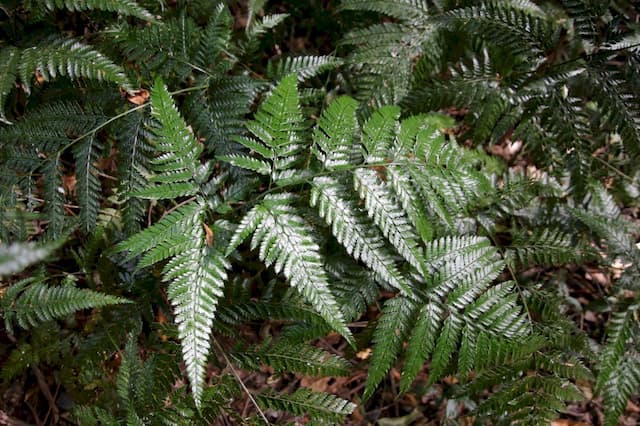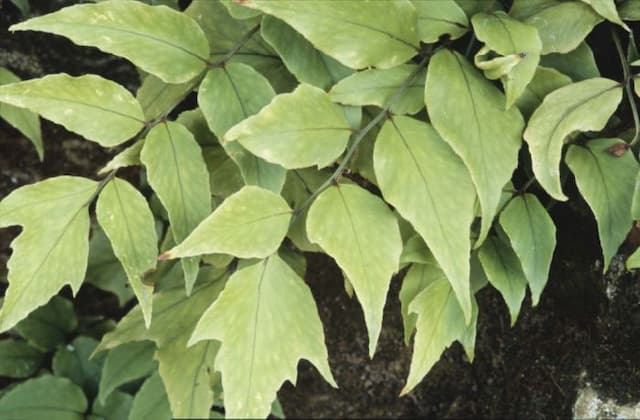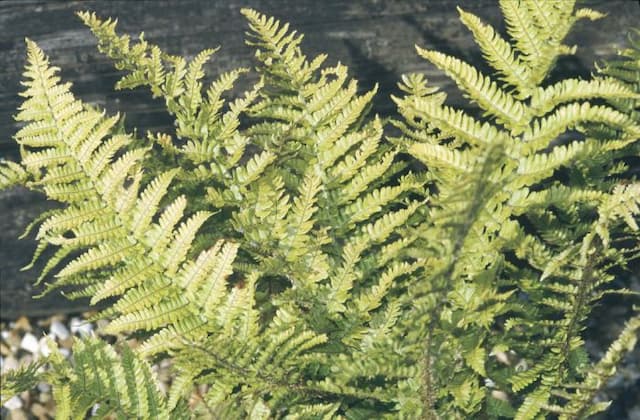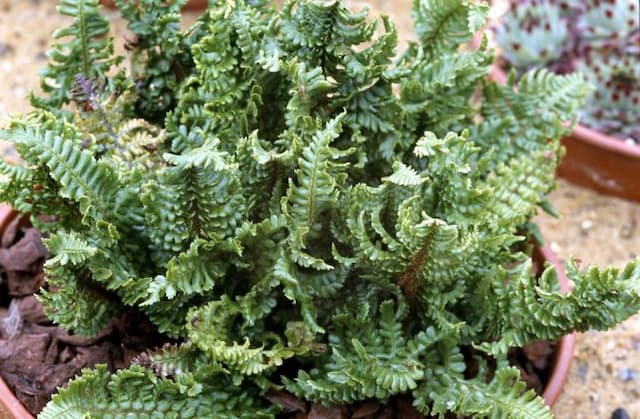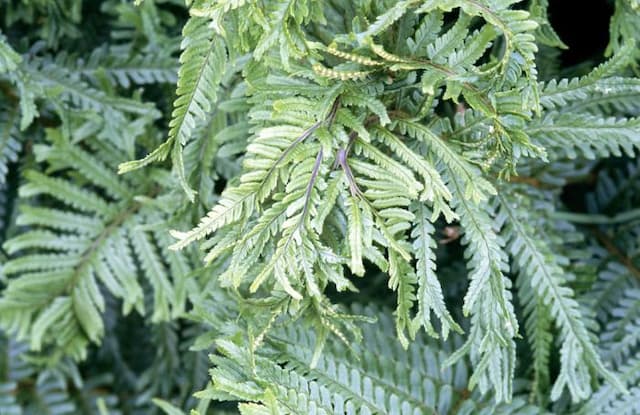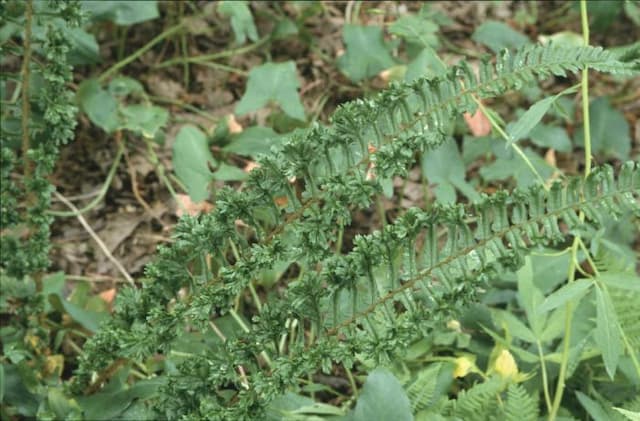Christmas fern Polystichum acrostichoides

ABOUT
The plant known most commonly as Christmas fern is a perennial fern with a lush and glossy green appearance. It boasts a clump-forming habit, where multiple fronds emerge from a central point, creating a dense and attractive cluster. The fronds are lance-shaped and finely divided, somewhat resembling a feather. They are arranged in a way that the plant sometimes looks like a fountain of greenery. Each leaflet on the frond, or pinnae as they are technically known, is shaped like a small Christmas stocking, which is a charming characteristic that contributes to its common name. The pinnae are attached to the frond in an alternate pattern, and they have a slightly leathery texture, adding to the visual interest and sturdiness of the frond. The color of the fronds is a rich, deep shade of green which tend to remain vibrant throughout the year, making the plant an excellent choice for adding color to a garden even during the colder months. As the fronds mature, they may arch gracefully, creating an elegant appearance. The undersides of the fronds are where the reproductive structures, called sori, are found. These appear as small clusters of brown or yellow dots, and they release spores for the plant to reproduce. These reproductive parts are typically obscured from view unless one looks closely beneath the frond. Overall, the appearance of the Christmas fern is one of durability and evergreen beauty, with its festive shape and verdant coloration contributing to its popularity both in wild settings and in cultivation for ornamental use.
About this plant
 Names
NamesSynonyms
Christmas Fern, Dagger Fern, Evergreen Wood Fern
Common names
Aspidium acrostichoides, Polystichum acrostichoides var. incisum, Polystichum acrostichoides var. latifolium, Aspidium acrostichoides var. incisum, Dryopteris acrostichoides.
 Toxicity
ToxicityTo humans
The Polystichum acrostichoides, commonly known as the Christmas fern, is not known to be toxic to humans. There are no well-documented cases of poisoning or toxic reactions in humans from ingesting or handling this plant. Therefore, it is generally considered safe and does not pose a risk of toxicity to humans if any part of the plant is ingested.
To pets
The Polystichum acrostichoides, or Christmas fern, is not toxic to pets such as dogs and cats. Ingesting parts of this plant is not known to cause any significant symptoms of poisoning in pets, making it a safe choice for areas where pets may have access. There are no recognized toxic compounds present in the plant that would typically lead to adverse health consequences for pets.
 Characteristics
CharacteristicsLife cycle
Perennials
Foliage type
Evergreen
Color of leaves
Green
Height
1-2 feet (0.3-0.6 meters)
Spread
1-3 feet (0.3-0.9 meters)
Plant type
Fern
Hardiness zones
3-9
Native area
North America
Benefits
 General Benefits
General Benefits- Landscape Aesthetics: Polystichum acrostichoides, commonly known as Christmas fern, adds year-round greenery to gardens with its lush, evergreen fronds.
- Erosion Control: Its dense root system helps stabilize soil on slopes and in shaded areas, preventing erosion caused by water runoff and wind.
- Habitat for Wildlife: The Christmas fern provides cover for small animals and birds, and its fronds may serve as nesting material for some species.
- Drought Resistance: Once established, the Christmas fern can tolerate periods of drought, making it a suitable choice for gardens with dry conditions.
- Low Maintenance: It requires very little upkeep, with no need for fertilization or regular trimming, making it an ideal plant for low-maintenance landscapes.
- Shade Tolerance: Christmas fern thrives in shady areas where many other plants struggle, offering a lush, green option for darker parts of the garden.
- Winter Interest: As an evergreen plant, Christmas fern provides color and texture in the garden throughout the colder months when other plants have died back.
- Soil Improvement: As the fronds of the Christmas fern die back and decompose, they contribute organic matter to the soil, which can improve soil health over time.
- Naturalizing Effect: Christmas fern is native to North America and blends well with other native plants, helping to create a naturalized area in the landscape.
 Medical Properties
Medical PropertiesThis plant is not used for medical purposes.
 Air-purifying Qualities
Air-purifying QualitiesThis plant is not specifically known for air purifying qualities.
 Other Uses
Other Uses- Christmas Decorations: Due to its evergreen nature and resemblance to holly, Christmas fern fronds are often used in holiday wreaths and floral arrangements.
- Erosion Control: The Christmas fern's ability to grow in dense colonies makes it an effective plant for stabilizing soil and preventing erosion on slopes and in shaded areas.
- Wildlife Habitat: It offers cover for small mammals and birds while also providing a food source for some species of wildlife during the winter months.
- Shade Garden Accent: The Christmas fern is prized for its ability to thrive in shady gardens where other plants may struggle to grow, providing texture and greenery year-round.
- Water Garden Companion: It can be planted near water features, such as ponds or streams, to add foliage interest without the fear of the fronds wilting in moist conditions.
- Ground Cover: Its dense growth habit allows it to serve as an effective ground cover, filling in large shaded areas and crowding out unwanted weeds.
- Gift Plant: With its attractive fronds and low maintenance, Christmas ferns are often potted and given as gifts, especially to those who enjoy gardening.
- Frost Protection: In milder climates, the fronds can be used to provide a light layer of frost protection for tender plants when draped over them during light freezes.
- Landscape Borders: The Christmas fern can be used as a border plant along walkways or garden edges, creating a tidy and natural boundary marker.
- Historical Cooking: Historically, some Native American tribes used the tightly-wound new fiddleheads of Christmas ferns as a source of food in the springtime.
Interesting Facts
 Feng Shui
Feng ShuiThe Christmas fern is not used in Feng Shui practice.
 Zodiac Sign Compitability
Zodiac Sign CompitabilityThe Christmas fern is not used in astrology practice.
 Plant Symbolism
Plant Symbolism- Resilience: The Christmas Fern, being an evergreen plant, is often associated with resilience as it maintains its greenery throughout the seasons, even in winter.
- Endurance: Its ability to endure cold winters also symbolizes endurance and the capacity to withstand difficult conditions.
- Protection: Ferns in general are sometimes thought to offer protection and have been used in traditional medicine, which may extend symbolically to the Christmas Fern.
- Eternal Youth: As an evergreen, the Christmas Fern symbolizes eternal youth and the idea of perpetual life, retaining its youthful appearance all year round.
- Hope: The green color of the Christmas Fern, especially during winter months, represents hope and the promise of spring and renewal.
 Water
WaterChristmas ferns should be watered deeply once a week, allowing the soil to slightly dry out between waterings. These ferns typically need about 1 gallon of water per watering session for each square yard of soil area. During particularly dry spells, increase watering frequency to ensure the soil remains consistently moist but not waterlogged. During the fall and winter, reduce watering slightly as the plant's growth slows down.
 Light
LightChristmas ferns thrive in partial to full shade, making them an excellent choice for shaded woodland gardens or north-facing areas of the yard. They do best when sheltered from the intense afternoon sun, which can scorch their fronds. The ideal spot for a Christmas fern would thus be under the canopy of trees or in a location where they receive filtered light throughout the day.
 Temperature
TemperatureChristmas ferns are hardy and can tolerate temperatures as low as 0 degrees Fahrenheit, making them suitable for many climates. They prefer a temperature range of 60-70 degrees Fahrenheit during the growing season. While they are quite resilient, extreme heat above 90 degrees Fahrenheit can stress the plants, so they should be protected from intense summer heat.
 Pruning
PruningPruning Christmas ferns is primarily for aesthetic purposes and to remove any damaged or dead fronds. Prune in early spring before new growth starts, cutting back any old fronds to make way for fresh ones. Pruning annually or as needed helps maintain a tidy appearance and encourages healthy growth. The best time for pruning is when you start to see new growth at the base of the plant.
 Cleaning
CleaningAs needed
 Soil
SoilChristmas Fern thrives best in a soil mix that is rich, loamy, and well-draining with an acidic to neutral pH between 5.0 and 7.0. A good mixture could be equal parts of garden soil, compost, and perlite or coarse sand to ensure proper drainage and aeration.
 Repotting
RepottingChristmas Ferns do not need to be repotted often, as they prefer to be somewhat root-bound. Repotting every 2 to 3 years or when the plant has visibly outgrown its container is sufficient.
 Humidity & Misting
Humidity & MistingChristmas Fern prefers medium to high humidity levels, ideally around 50% or higher, to thrive. However, it is quite adaptable and can tolerate lower humidity levels commonly found in home environments.
 Suitable locations
Suitable locationsIndoor
Place Christmas Fern in low to medium light and maintain high humidity.
Outdoor
Plant Christmas Fern in shade to partial sun in moist soil.
Hardiness zone
Christmas Fern is suitable for USDA zones 3-9.
 Life cycle
Life cyclePolystichum acrostichoides, commonly known as Christmas fern, begins its life cycle as a spore, which germinates in moist, shaded environments to produce a small, heart-shaped gametophyte. The gametophyte, through sexual reproduction, gives rise to a young sporophyte, which is the fern's familiar leafy stage. The plant matures and develops fronds with sori on their undersides, these sori contain sporangia where meiosis occurs, producing haploid spores. These spores are released into the environment to restart the life cycle when conditions are favorable. The Christmas fern is an evergreen perennial, so individual plants can live for many years, continuing to produce new fronds – and therefore spores – each growing season. The fern thrives in the dappled shade of forest floors and requires consistently moist soil to support both the gametophyte and sporophyte stages.
 Propogation
PropogationPropogation time
Spring to Summer
The most popular method for propagating Christmas fern, which is the common name for Polystichum acrostichoides, is by division. This typically occurs in the spring, just before new growth starts. To propagate by division, the root ball of a mature plant should be gently dug up and sections of the crown with at least one frond and corresponding root system are separated. These divisions should then be planted at the same depth they were previously growing, spaced about 18 inches (approximately 46 centimeters) apart to allow for growth. The soil around the new plants should be kept moist but not saturated to encourage root development and establishment.
